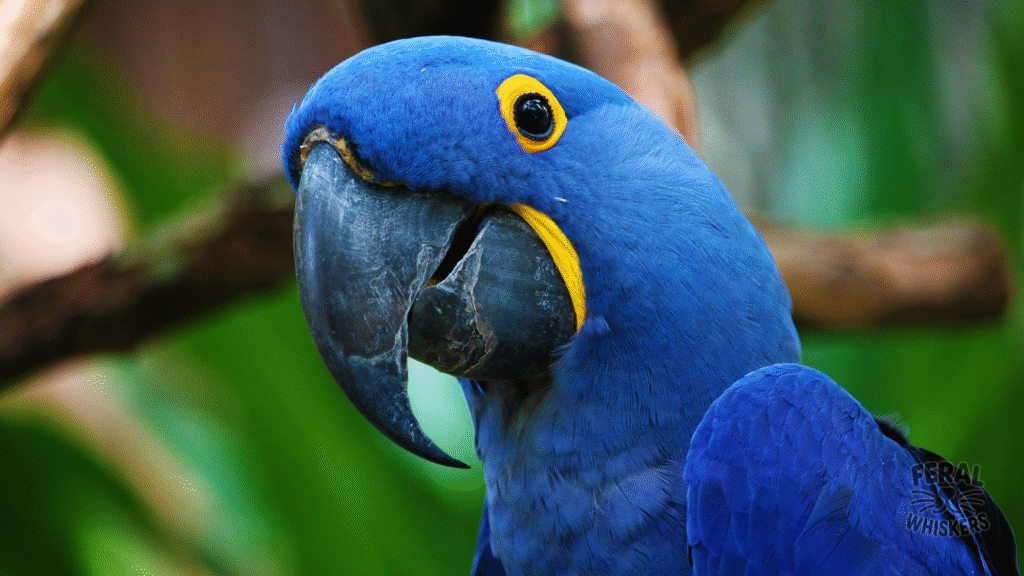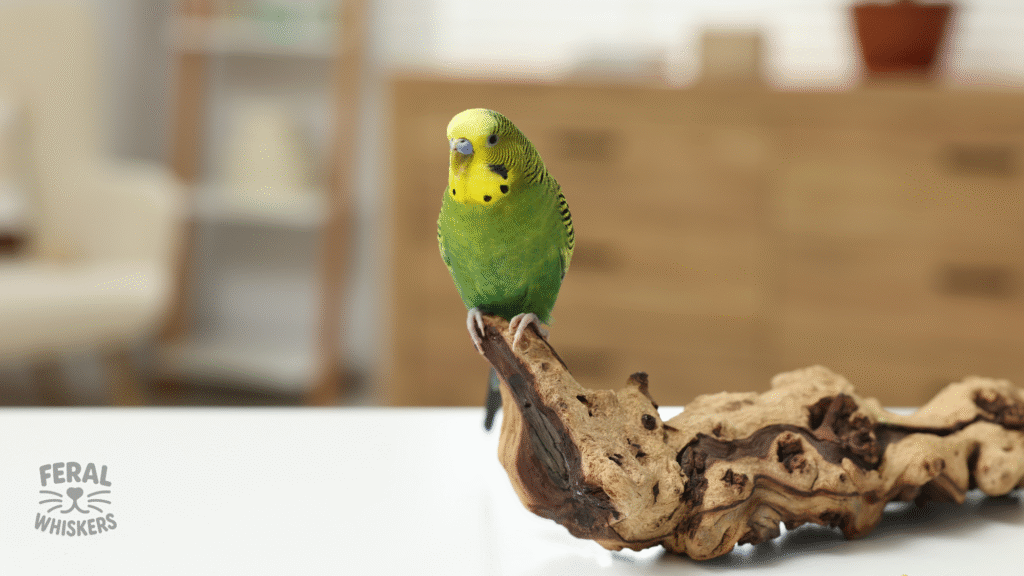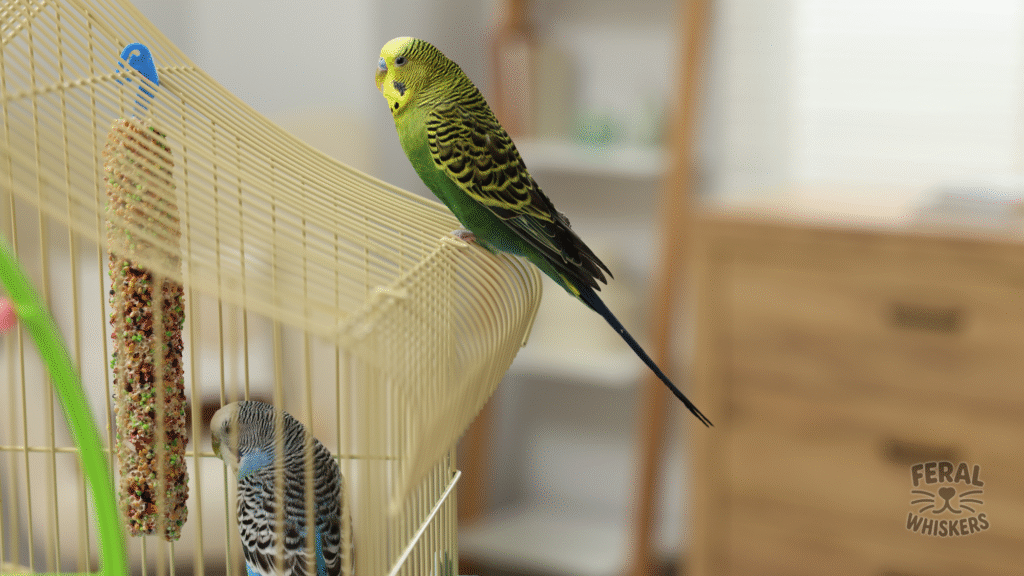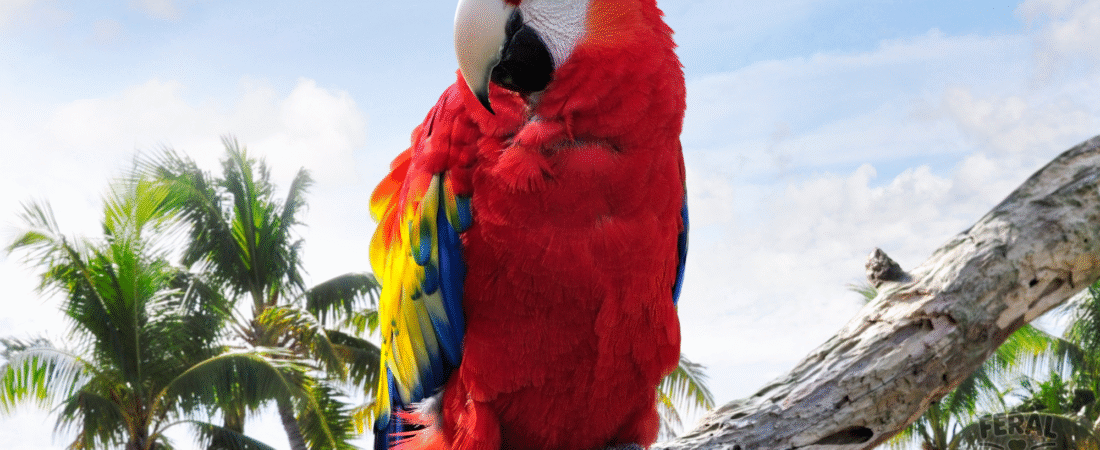The Gift of Gab: Why Parrots Talk

Few things captivate animal lovers more than a parrot that can “talk.” The ability of these intelligent birds to mimic human speech, sing songs, and even understand context is truly remarkable. But why do parrots talk, and how can we encourage this incredible behavior while building a strong, trusting bond?
Understanding vocal mimicry in parrots goes beyond just teaching them words. It’s about tapping into their natural intelligence, social instincts, and desire to communicate within their flock – which, in a home environment, is you!
1. Why Parrots Mimic Human Speech: More Than Just Copying
Parrots don’t have vocal cords like humans. Instead, they use a specialized organ called the syrinx to produce a wide range of sounds. Their ability to mimic is rooted in several key factors:
- Social Animals: Parrots are highly social flock animals. In the wild, they use complex vocalizations to communicate with their flock members, identify each other, warn of predators, and share information.
- Flock Integration: When a parrot joins a human family, you become their “flock.” Mimicking human speech is their way of trying to integrate, communicate, and bond with you. They are trying to “speak your language.”
- Intelligence: Parrots are incredibly intelligent birds, capable of problem-solving and learning. Their vocal mimicry is a testament to their cognitive abilities.
- Attention & Reinforcement: Parrots quickly learn that certain sounds (like human words) get a reaction from their human flock. If they get attention, praise, or a treat for saying something, they are more likely to repeat it.
- Contextual Learning: The most amazing aspect is that many parrots don’t just copy sounds; they learn to associate words with objects, actions, or situations. They can learn to say “hello” when someone enters the room or “want a cracker” when they see a treat.
2. Which Parrot Species Are Best Known for Talking?
While many parrot species can mimic, some are renowned for their exceptional talking abilities:
- African Grey Parrots: Often considered the “Einsteins” of the parrot world, known for their incredible vocabulary, clarity, and ability to use words in context. They can learn hundreds of words and phrases.
- Amazon Parrots (e.g., Yellow-naped, Double Yellow-headed, Blue-fronted): Excellent talkers with clear voices and a knack for singing and mimicking sounds. They often have a more “operatic” quality to their speech.
- Quaker Parrots (Monk Parakeets): Known for their early talking ability and clear voices. They can develop extensive vocabularies.
- Eclectus Parrots: While not as prolific as African Greys, they can be good talkers, often with a sweet, gentle tone.
- Indian Ringneck Parakeets: Can develop impressive vocabularies and clarity, often with a distinct, somewhat metallic voice.
- Budgerigars (Parakeets): Don’t underestimate these small birds! While their voices are often softer and less clear, some male budgies can develop incredibly large vocabularies.
Important Note: Not every individual bird within these species will talk. Talking ability varies greatly from bird to bird, regardless of species. Some birds prefer to mimic household sounds, whistles, or simply enjoy being quiet companions.
3. Training Tips for Safe, Positive Communication
Encouraging your parrot to talk should always be a positive, bonding experience.
3.1 Start Early and Be Consistent
- Puppy/Baby Stage: The best time to start is when they are young, but older birds can certainly learn too.
- Repetition: Say words and phrases clearly and consistently. Repeat them often, especially when performing an associated action (e.g., “hello” when you enter, “goodbye” when you leave, “want a treat” when offering one).
3.2 Make it Fun and Engaging
- Enthusiasm: Use an excited, happy tone of voice. Parrots respond well to enthusiasm.
- Short Sessions: Keep training sessions brief (5-10 minutes) and positive to prevent boredom.
- Playtime: Incorporate words into playtime. “Peek-a-boo” is a classic.
3.3 Use Positive Reinforcement
- Reward Success: When your parrot attempts a word or phrase, even if it’s just a sound, immediately reward them with praise, a favorite treat, or a head scratch.
- Avoid Punishment: Never scold or punish your parrot for not talking or for making unwanted sounds. This will only create fear and damage your bond.
3.4 Create a Language-Rich Environment
- Talk to Your Bird: Narrate your actions. “Mommy’s getting coffee,” “Time for dinner,” “What a pretty bird!”
- Music & TV: Some birds enjoy music or background noise, but direct interaction is more effective for teaching speech.
- Recordings: You can use recordings of your own voice, but live interaction is always best.
3.5 Focus on Contextual Learning
- Associate Words with Objects: Hold up an apple and say “apple.” Give them the apple. Repeat.
- Associate Words with Actions: Say “step up” as you offer your hand. Say “good night” when covering the cage.
- Simple Phrases First: Start with single words or short phrases like “hello,” “bye-bye,” “pretty bird,” “what’s up?”
3.6 Be Patient
- Some parrots pick up words quickly, others take months or even years. Some never talk. Enjoy their unique personality regardless.
4. Myths About Parrot Talking
- “All parrots talk.” False. While many species can talk, not every individual bird will. It depends on personality, environment, and training.
- “Female parrots don’t talk.” False. While male budgies are often better talkers, females of many larger parrot species can talk just as well as males.
- “Talking parrots are smarter than non-talking parrots.” False. A parrot’s intelligence is not solely measured by its ability to mimic speech. Many non-talking parrots are incredibly intelligent and can be trained to do complex tricks.
- “You need to clip their tongue for them to talk.” ABSOLUTELY FALSE AND HARMFUL. This is an old, cruel myth. Never attempt to alter a bird’s tongue. It’s unnecessary and causes severe pain and injury.
5. When to Seek Behaviorist Help
If your parrot is exhibiting unwanted vocalizations (screaming, repetitive loud noises) that are not related to normal communication or attention-seeking, or if they are showing signs of aggression or fear, it’s time to consult a certified avian behaviorist or an avian veterinarian with behavior expertise.
- Excessive Screaming: Can be a sign of boredom, fear, lack of attention, or an underlying medical issue.
- Self-Mutilation/Feather Plucking: Often linked to stress, boredom, or medical problems.
- Aggression: Biting, lunging, or guarding behavior.
A behaviorist can help identify the root cause and develop a positive behavior modification plan.
6. Bonding Beyond Words: The Foundation of Communication
While talking is amazing, the true joy of parrot ownership comes from the bond you share. This bond is built on trust, respect, and understanding, whether your bird speaks or not.
- Gentle Handling: Always approach your bird calmly and gently.
- Respect Their Space: Learn their body language (see previous articles!) and know when they want interaction and when they need space.
- Consistent Routine: Predictable schedules for feeding, play, and sleep reduce stress.
- Positive Reinforcement: Reward good behavior, never punish.
- Quality Time: Spend time interacting, playing, and simply being present with your bird.
- Grooming: Regular nail trims and wing clips (if necessary and done by a professional) can make handling easier and safer.
7. Fun Facts About Parrot Vocalizations

- Dialects: Wild parrot flocks often develop unique “dialects” or calls specific to their group.
- Lifelong Learners: Parrots can continue to learn new words and sounds throughout their lives.
- Contextual Understanding: Some parrots, like Alex the African Grey, demonstrated an impressive ability to understand concepts like “same/different,” colors, and numbers, using human words to express these ideas.
- Sound Effects: Many parrots are excellent at mimicking household sounds like doorbells, phones, microwaves, and even car alarms!
8. Common FAQs for Parrot Owners

Q1: How long does it take for a parrot to start talking?
A: It varies greatly. Some may say their first words within months, others take a year or more, and some never talk. Patience and consistency are key.
Q2: My parrot only whistles, not talks. Is that normal?
A: Absolutely! Many parrots prefer to whistle, mimic other sounds, or simply communicate through body language. Whistling is a form of vocalization and a sign of engagement.
Q3: Should I get two parrots so they can talk to each other?
A: If you want a talking parrot that bonds with you, getting two birds might make them bond more with each other and less with you, potentially reducing their desire to mimic human speech. If you want two birds, be prepared for them to communicate primarily with each other.
Q4: My parrot screams a lot. Is it trying to talk?
A: Excessive screaming is usually not an attempt to talk. It’s often a sign of boredom, fear, seeking attention, or an unmet need. Try increasing enrichment, ensuring enough attention, and ruling out medical issues.
Q5: Can parrots learn bad words?
A: Yes, they can! They pick up on words that get a strong reaction. If you don’t want your parrot to say a certain word, avoid saying it around them, especially with an emotional tone.
Q6: Do talking parrots understand what they’re saying?
A: While they don’t understand in the same complex way humans do, many parrots do learn to associate words and phrases with specific contexts, objects, or actions, demonstrating a level of comprehension.
Q7: Is it true that only male parrots talk?
A: No, this is a myth for most larger parrot species. Both male and female parrots can be excellent talkers. For budgies, males are generally more inclined to talk.
Q8: My parrot stopped talking. What happened?
A: Changes in environment, stress, illness, or even a change in your routine can affect a parrot’s vocalizations. If it’s a sudden change, consult an avian vet to rule out health issues.
Q9: How can I encourage my shy parrot to talk?
A: Create a calm, consistent environment. Use a soft, encouraging voice. Offer high-value treats for any vocalizations. Don’t force interaction. Building trust is paramount.
Q10: What’s the best way to teach my parrot a new word?
A: Choose one word, say it clearly and enthusiastically, associate it with an action or object, and repeat it consistently. Reward any attempts at mimicry immediately.
Final Takeaway for Animal Lovers
The ability of parrots to mimic human speech is a truly extraordinary trait, but it’s just one facet of their incredible intelligence and social nature. By understanding why they talk, using positive reinforcement training, and focusing on building a deep, trusting bond, you can foster a communicative and enriching relationship with your feathered friend. Whether your parrot becomes a chatterbox or a quiet companion, the joy of their unique personality and the bond you share are the most rewarding aspects of parrot ownership.

